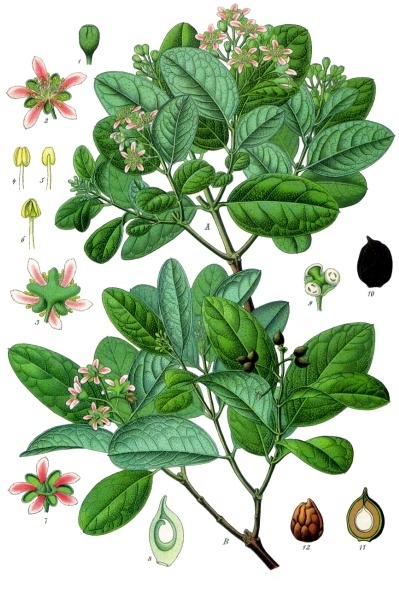 Boldo
Boldo
Common name
Boldo Leaf
ID
HD0100
Scientific name of the plant
Peumus boldus Molina
Anatomical part for use
leaf
Human use
Gastrointestinal disorders
Summary
"Boldo" is also a settlement in Arauco Province (Chile) named after this tree.
Peumus boldus, the only species in the genus Peumus, is commonly known as boldo (from the Mapudungun name foḻo). This tree of the family Monimiaceae is natively endemic to the central region of Chile, occurring from 33° to 40° southern latitude. Boldo has also been introduced to Europe and North Africa, though it is not often seen outside botanical gardens.
Due to its common name (Boldo), mainly in Latin America, it is usually confused with the Plectranthus ornatus species, known as Falso Boldo (Fake Boldo), "Boldo" paraguayo or "Boldo" rastrero; which has led to confusion about the uses, and the properties and toxicity of both species.
Evidence Level
Level 2 (Independent reports from multiple medical centers)
Hepatotoxicity reports in literature
Hepatotoxicity Description
N/A
Uses
In Brazil, Argentina, Chile, Uruguay, and Paraguay, boldo is mixed with yerba mate or other teas to moderate its flavor. Some families keep a boldo plant at home for this purpose, although boldo teabags are readily available in nearly all supermarkets.
Boldo and plants with similar properties are widely used as mild folk medicine in various South American countries in both urban and rural areas, even among people who do not usually drink herbal teas other than mate beverage. Boldo is officially listed as phytotherapic plant as cholagogue and choleretic, for treatment of mild dyspepsia in Brazilian pharmacopoeia.Boldo is in the family Monimiaceae, which is closely related to the family Lauraceae (which includes many other plants used for their aromatic leaves, such as cinnamon, cassia, bay leaf, and camphor laurel.)
Boldo leaves have slightly bitter soft flavor and a bit coniferous rough taste when brewed in tea. They are used as a culinary herb to spice many savory dishes with fish, mushrooms, vegetables and as a component in sauces. In some local South American kitchens boldo leaves are also popular to wrap frying fish and meat.
Boldo fruits, when dried, are used to make spicy condiments. (Source: Wiki)

Common name
Boldo Leaf
ID
HD0100
Scientific name of the plant
Peumus boldus Molina
Anatomical part for use
leaf
Human use
Gastrointestinal disorders
Summary
"Boldo" is also a settlement in Arauco Province (Chile) named after this tree. Peumus boldus, the only species in the genus Peumus, is commonly known as boldo (from the Mapudungun name foḻo). This tree of the family Monimiaceae is natively endemic to the central region of Chile, occurring from 33° to 40° southern latitude. Boldo has also been introduced to Europe and North Africa, though it is not often seen outside botanical gardens. Due to its common name (Boldo), mainly in Latin America, it is usually confused with the Plectranthus ornatus species, known as Falso Boldo (Fake Boldo), "Boldo" paraguayo or "Boldo" rastrero; which has led to confusion about the uses, and the properties and toxicity of both species.
Evidence Level
Level 2 (Independent reports from multiple medical centers)
Hepatotoxicity reports in literature
Hepatotoxicity Description
N/A
Uses
In Brazil, Argentina, Chile, Uruguay, and Paraguay, boldo is mixed with yerba mate or other teas to moderate its flavor. Some families keep a boldo plant at home for this purpose, although boldo teabags are readily available in nearly all supermarkets. Boldo and plants with similar properties are widely used as mild folk medicine in various South American countries in both urban and rural areas, even among people who do not usually drink herbal teas other than mate beverage. Boldo is officially listed as phytotherapic plant as cholagogue and choleretic, for treatment of mild dyspepsia in Brazilian pharmacopoeia.Boldo is in the family Monimiaceae, which is closely related to the family Lauraceae (which includes many other plants used for their aromatic leaves, such as cinnamon, cassia, bay leaf, and camphor laurel.) Boldo leaves have slightly bitter soft flavor and a bit coniferous rough taste when brewed in tea. They are used as a culinary herb to spice many savory dishes with fish, mushrooms, vegetables and as a component in sauces. In some local South American kitchens boldo leaves are also popular to wrap frying fish and meat. Boldo fruits, when dried, are used to make spicy condiments. (Source: Wiki)